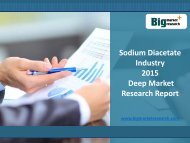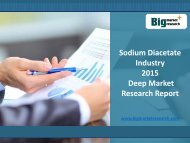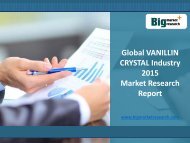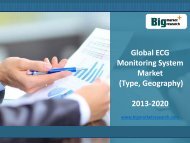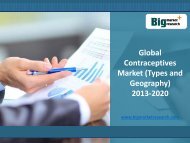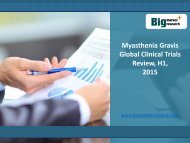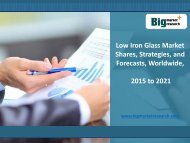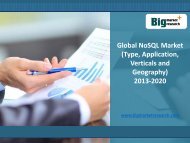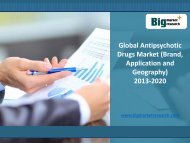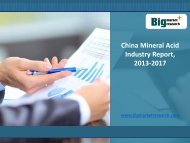Global Acrylic Acid Market Insights, Demand (Derivatives Types) 2013-2020
Big Market Research, Global Acrylic Acid Market Size, Share, Global Trends, Company Profiles, Demand, Insights, Analysis, Research, Report, Opportunities, Segmentation and Forecast, 2013 – 2020. Get complete report @ http://www.bigmarketresearch.com/acrylic-acid-market The global acrylic acid market was valued at $11,006.6 million in 2013, and it is estimated to reach $18,824.0 million by 2020, growing at a CAGR of 7.6% during the forecast period (from 2014 to 2020). The global consumption of acrylic acid is anticipated to reach 8,169.0 kilo tons by 2020. Acrylic acid is an organic compound having characteristic tart or acrid smell. A large portion of acrylic acid is used as a feedstock for obtaining acrylate esters. Acrylate esters have a broad spectrum of application in paper treatment, plastic additives, textiles, sealants, adhesives, and surface coatings.
Big Market Research, Global Acrylic Acid Market Size, Share, Global Trends, Company Profiles, Demand, Insights, Analysis, Research, Report, Opportunities, Segmentation and Forecast, 2013 – 2020. Get complete report @ http://www.bigmarketresearch.com/acrylic-acid-market
The global acrylic acid market was valued at $11,006.6 million in 2013, and it is estimated to reach $18,824.0 million by 2020, growing at a CAGR of 7.6% during the forecast period (from 2014 to 2020). The global consumption of acrylic acid is anticipated to reach 8,169.0 kilo tons by 2020. Acrylic acid is an organic compound having characteristic tart or acrid smell. A large portion of acrylic acid is used as a feedstock for obtaining acrylate esters. Acrylate esters have a broad spectrum of application in paper treatment, plastic additives, textiles, sealants, adhesives, and surface coatings.
- TAGS
- big-market-research
- acrylic-acid-market-forecast
- acrylic-acid-market-insights
- acrylic-acid-market-demand
- acrylic-acid-market-trends
- acrylic-acid-market-share
- acrylic-acid-market-size
- acrylic-acid
- global-acrylic-acid-market
- acrylic-acid-market
- acrylic
- analysis
- acquired
- hemolytic
- anemia
- industries
- global
- adhesives
- forecast
- factors
You also want an ePaper? Increase the reach of your titles
YUMPU automatically turns print PDFs into web optimized ePapers that Google loves.
<strong>Global</strong> <strong>Acrylic</strong> <strong>Acid</strong><br />
<strong>Market</strong> (<strong>Derivatives</strong><br />
<strong>Types</strong>, End Users and<br />
Geography)<br />
<strong>2013</strong>-<strong>2020</strong><br />
www.bigmarketresearch.com
Report Description<br />
Acquired (Autoimmune) Hemolytic Anemia<br />
<strong>Acrylic</strong> acid is an organic compound having characteristic tart or acrid smell. A large<br />
portion of acrylic acid is used as a feedstock for obtaining acrylate esters. Acrylate esters<br />
have a broad spectrum of application in paper treatment, plastic additives, textiles,<br />
sealants, adhesives, and surface coatings. Industries are developing and commercializing<br />
processes for producing acrylic acid from petrochemicals. Due to the rising price of oil<br />
globally, manufacturers are using bio-based techniques to produce acrylic acid and<br />
acrylates from renewable resources such as glycerol, sugar, etc. Renewable feedstock<br />
shows cost competitive outcomes as compared to petrochemical routes. The global<br />
acrylic acid market was valued at $11,006.6 million in <strong>2013</strong>, and it is estimated to reach<br />
$18,824.0 million by <strong>2020</strong>, growing at a CAGR of 7.6% during the forecast period (from<br />
2014 to <strong>2020</strong>). The global consumption of acrylic acid is anticipated to reach 8,169.0 kilo<br />
tons by <strong>2020</strong>.<br />
Read complete report here @<br />
http://www.bigmarketresearch.com/acrylic-acid-market
Report Description<br />
Acquired (Autoimmune) Hemolytic Anemia<br />
The factors that are driving the growth of the market are soaring demand for<br />
superabsorbent polymers, widespread adoption of acrylic-based products in emerging<br />
economies such as Asia Pacific and growing industries such as adhesives and sealants.<br />
Stringent government regulations are imposed on the use of acrylic acid due to<br />
increasing environmental concerns in regions such as North America, Europe, etc., to<br />
protect the environment and prevent occupational exposure of acrylic acid. Due to the<br />
potential restraints, the growth of the acrylic acid market is restricted. Producers of<br />
acrylic acid are focusing on research and development to find the bio-based roots for the<br />
production of acrylic acid. Moreover, commercialization of bio-based acrylic acid and<br />
saturated demand for PMMA resins in various industries would open doors for investors<br />
to invest in acrylic acid market; thus, creating lot of opportunities for the growth of<br />
acrylic acid market in the near future.<br />
Download Sample Report @<br />
http://www.bigmarketresearch.com/request-sample/20123
Table Of Contents<br />
Acquired (Autoimmune) Hemolytic Anemia<br />
CHAPTER 1. INTRODUCTION<br />
CHAPTER 2. EXECUTIVE SUMMARY<br />
CHAPTER 3. MARKET OVERVIEW<br />
CHAPTER 4. GLOBAL ACRYLIC ACID MARKET BY DERIVATIVE TYPES<br />
CHAPTER 5. GLOBAL ACRYLIC ACID MARKET BY END USERS<br />
CHAPTER 6. GLOBAL ACRYLIC ACID MARKET BY GEOGRAPHY<br />
CHAPTER 7. COMPANY PROFILES<br />
Read complete TOC @<br />
http://www.bigmarketresearch.com/acrylic-acid-market
Report Description<br />
Acquired (Autoimmune) Hemolytic Anemia<br />
Reason for Doing the Study<br />
<strong>Acrylic</strong> acid has been in production for nearly 30 years. <strong>Demand</strong> for acrylic acid is<br />
increasing year on year due to its various end users in superabsorbent, adhesive, surface<br />
coating, etc. Apart from this, many new applications emerged due to commercialization<br />
of the manufacturing techniques of bio-acrylic acid. <strong>Acrylic</strong> acid market has huge<br />
potential in the future, as it would create a range of applications, namely in industries<br />
such as surfactants industry, surface coatings industry, adhesives & sealants industry,<br />
plastic additives & co-monomers, etc. Thus, understanding of the acrylic acid market<br />
would provide intelligence about the entire market segment and it would thus, help the<br />
stakeholders to make strategic decisions.
Report Description<br />
Acquired (Autoimmune) Hemolytic Anemia<br />
<strong>Acrylic</strong> <strong>Acid</strong> Derivative Type <strong>Market</strong> Analysis<br />
<strong>Acrylic</strong> acid derivative type market is segmented into acrylic esters, acrylic polymers and<br />
other derivatives. <strong>Acrylic</strong> esters is and would continue to lead the overall acrylic acid<br />
derivative types market throughout <strong>2020</strong> in terms of revenue generation. <strong>Acrylic</strong><br />
polymers segment is anticipated to be the fastest growing segment during the forecast<br />
period. <strong>Acrylic</strong> Polymers are widely used for coatings binders, gun turrets, bomber noses,<br />
aircraft canopies, cosmetic industry, etc. <strong>Acrylic</strong> polymers is popular for its stability,<br />
superior technology and chemical purity due to which it is used in the applications where<br />
there is a need for resistance to aging & weathering, transparency and color stability.<br />
These factors are eliciting the growth of acrylic polymers. However, due to growing<br />
adoption of acrylic esters for producing adhesives, water-based paints, synthetic rubbers<br />
and synthetic resins, it holds tremendous potential for the growth of acrylic acid market<br />
during the forecast period.
Report Description<br />
Acquired (Autoimmune) Hemolytic Anemia<br />
<strong>Acrylic</strong> <strong>Acid</strong> End user <strong>Market</strong> Analysis<br />
<strong>Acrylic</strong> acid end user market is segmented into diapers, surface coating, adhesives and<br />
sealants, plastic additive industry, water treatment, textiles and surfactants. Currently,<br />
acrylic acid is majorly consumed in manufacturing diapers; this segment would dominate<br />
the global acrylic acid market through <strong>2020</strong>. Surfactants industry is the fastest growing<br />
segment, growing at a CAGR of 8.6% during the forecast period. <strong>Acrylic</strong> based surfactants<br />
are used as binders that enhance the flexibility, gloss and durability of the coatings.<br />
Moreover, acrylic acid increases the shelf life of paints; improve the stability of freezethaw<br />
and mechanical stability. These factors are driving the demand for acrylic acid in<br />
surfactants industry.<br />
Get enquire about report @<br />
http://www.bigmarketresearch.com/report-enquiry/20123
Report Description<br />
Acquired (Autoimmune) Hemolytic Anemia<br />
<strong>Acrylic</strong> <strong>Acid</strong> Geography <strong>Market</strong> Analysis<br />
<strong>Acrylic</strong> acid geography market is segmented into North America, Europe, Asia Pacific and<br />
LAMEA. In <strong>2013</strong>, Asia–Pacific was the largest revenue-generating region and it is forecast<br />
that the region would continue to dominate the revenue streams through <strong>2020</strong>. LAMEA<br />
is the fastest growing region that is growing at a CAGR of 9.3% during the forecast period.<br />
LAMEA brings lot of opportunities for the growth of the acrylic acid market. The factors<br />
that are driving the growth of the market in the region are the widespread adoption of<br />
renewable roots for producing acrylic acid and growing industries such as coatings,<br />
sealants, adhesive, etc. Moreover, LAMEA has a lucrative market for the production of<br />
crude acrylic acid due to the presence of world’s largest petrochemicals sites. These<br />
factors result in driving the demand for acrylic acid in LAMEA.
Report Description<br />
Acquired (Autoimmune) Hemolytic Anemia<br />
Competitive Analysis<br />
The key strategies adopted by the companies to expand in the acrylic acid market are<br />
product launches, acquisitions and agreements & collaborations. Strategic analysis of the<br />
companies reveals that most of the companies are concentrating on product launch, and<br />
agreements for the expansion of their business. These strategies resulted in the<br />
advancement of the technology and diversification of the products in the untapped<br />
areas. These strategies were adopted by the companies to diversify their business in the<br />
industries such as surfactants, surface coatings, adhesives, sealants, plastics additives,<br />
etc. Companies profiled in the report include Dow Chemical Company, BASF SE, Arkema<br />
SA, The Lubrozol Corporation, LG Chem LTD., Evonik Industries Ag, SIBUR, Myriant<br />
Corporation, SunVic Chemical Holdings Limited and Momentive Specialty Chemicals.
Report Description<br />
Acquired (Autoimmune) Hemolytic Anemia<br />
High-Level Analysis<br />
Porter’s five-force analysis measures the bargaining power of buyers and suppliers<br />
including the rivalry scenario in the market. The bargaining power of suppliers is high due<br />
to the oligopolistic environment. Lack of price sensitivity leads to lower bargaining power<br />
of the buyers. The value chain analysis presents a clear understanding that acrylic acid<br />
acts as the building blocks for specialty chemicals that are used by various industries to<br />
manufacture paints, coatings, adhesives, etc.
Report Description<br />
Acquired (Autoimmune) Hemolytic Anemia<br />
KEY BENEFITS<br />
• Analysis of the <strong>Acrylic</strong> acid <strong>Market</strong> based on various segments such as by derivative<br />
types, end users and geography is expounded in the report. Segmental analysis is also<br />
done in order to determine the largest revenue generating segment<br />
• To study the various factors that are strengthening and restraining the growth of the<br />
market that would help the market players to gain a deeper understanding the market<br />
• Qualitative as well as quantitative analysis of the current market conditions coupled<br />
with future estimations through <strong>2013</strong>-<strong>2020</strong> would help stakeholders take strategic and<br />
profitable decisions
Report Description<br />
Acquired (Autoimmune) Hemolytic Anemia<br />
KEY BENEFITS<br />
• Geographic analysis of the market would help the companies to plan and take region<br />
specific decisions<br />
• Porter’s five forces model helps to understand the bargaining power of buyers and<br />
suppliers and threat of the new entrants<br />
• Analysis of the captivating strategies adopted by the market players is conducted that<br />
would assist the stakeholders to take actionable decisions<br />
• The analysis focuses on the wide variety of opportunities for the growth and<br />
expansion of the market<br />
Request for Discount @ http://www.bigmarketresearch.com/purchase-enquiry/20123
FOR MORE DETAILS<br />
Visit us at :<br />
http://www.bigmarketresearch.com/acrylic-acid-market<br />
Stay With Us:<br />
TELEPHONE: +1 (855) 711-1555<br />
E-MAIL: help@bigmarketresearch.com<br />
5933 NE Win Sivers Drive,<br />
#205, Portland, OR 97220<br />
United States



